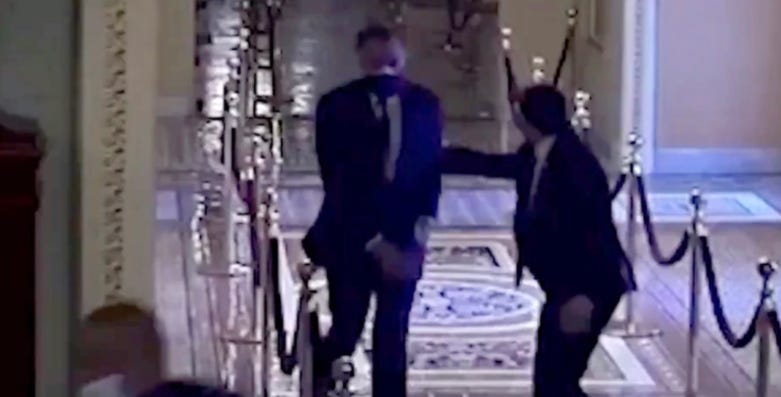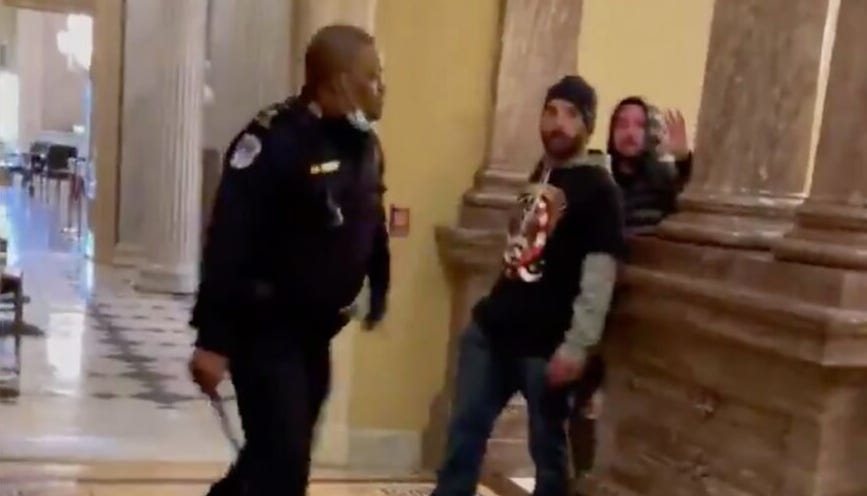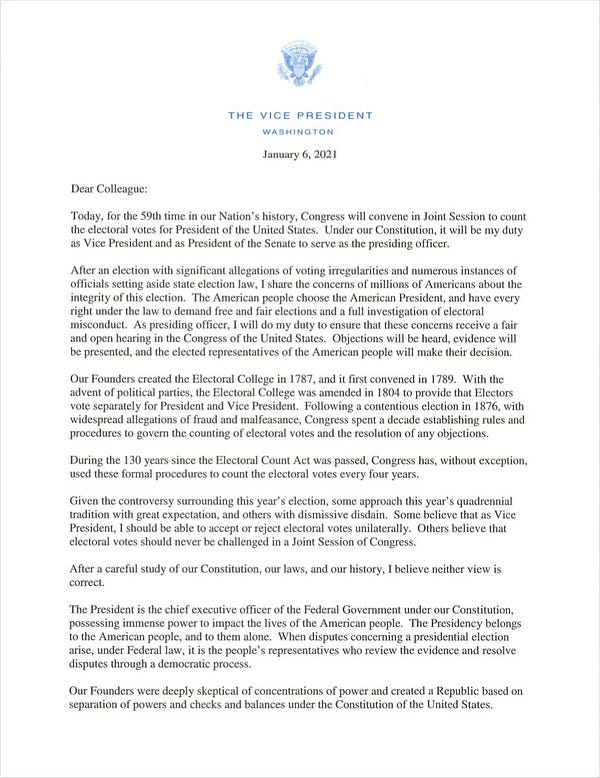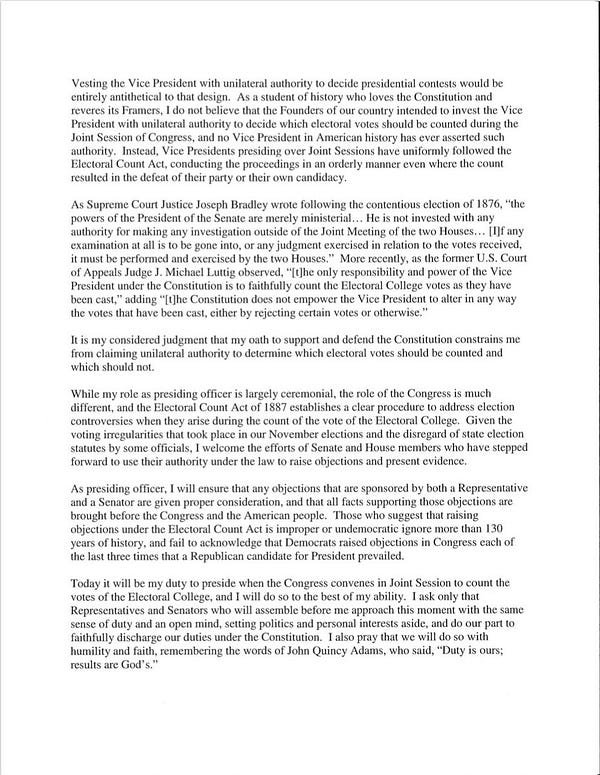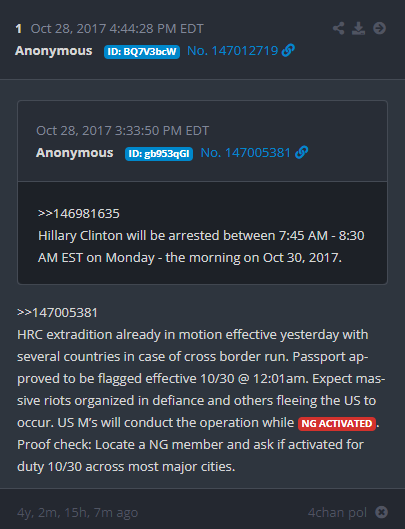It could have been so much worse: America got lucky on Jan 6
The January 6 Capitol riot was a disaster, but it was almost much worse. A look at some of worst-case scenarios that were narrowly avoided.
This is the second in a series of three articles I’m writing about the storming of the Capitol on January 6.
The assault on the US Capitol on January 6, 2021 was, of course, a disaster. Hundreds injured, several deaths, damage, the transfer of power disrupted as the Joint Session of Congress to count the Electoral votes was suspended for hours. National trauma and international humiliation.
But it could have been a lot worse.
Some of the scenarios that follow are were a little unlikely, but I think some were actually more probable paths than the path history ultimately followed that day. All of them are at least plausible. On January 6, America got lucky.
They could have taken (or killed) hostages
The Capitol invaders came very close to capturing Members of Congress. Officer Eugene Goodman helped rush Mitt Romney to safety as one mob of rioters closed on the Senate. Romney was particularly despised by Trump’s supporters for his vote in favour of impeachment.
Goodman then drew the mob away from the doors to the Senate chamber, baiting them into following him upstairs and away from the Senators who had just begun to flee the room. Had the mob arrived just a couple of minutes earlier, they would also have run into Mike Pence with his small Secret Service detail.
Elsewhere, about half an hour later, another mob was besieging the House of Representatives. House members, journalists and others were trapped in the chamber. At a battle to enter the Speaker’s Lobby, which contains entrances to the House chamber itself, rioters broke the windows and started to climb through. The first rioter to attempt to get through the window, Ashli Babbitt, was shot by Capitol police. She later died.
If Officer Goodman had been assigned to a different post that day. If the mob had been a minute or two earlier to the Senate. If the House had been breached. If any of the smaller mobs had found lone Members of Congress taking shelter in offices or bathrooms. If any number of things had gone just a tiny bit differently, the Capitol invaders would have come face-to-face with their enemy: the Democrats, the RINOs or the newly-hated Mike Pence.
There’s a good chance that, faced with the true enemy, they’d have attacked. Maybe that attack would have been a beating — and a mob beating can quickly escalate into a lynching. But maybe they would have taken hostages.
It should be obvious that a hostage situation would have been a disaster. There are no demands that the mob had that could possibly be met by negotiators, and the hostage Congressmen wouldn’t, in their eyes, be innocent bargaining collateral but rather people deserving of punishment themselves. The mob itself consisted of unstable, desperate, angry and unpredictable people who would have struggled to stay unified.
A hostage situation on January 6 would only have ended in blood. Maybe the blood of the hostage-takers as FBI SWAT teams moved in; maybe the blood of Senators, Members and journalists as the hostage-takers started killing; most likely, both. The Joint Session would not have recommenced that evening, and the transition of power would have been disrupted even longer.
And it’s quite possible that Trump would have taken this opportunity to take personal control of the D.C. National Guard and invoke the Insurrection Act under the guise of restoring order, taking the country into dangerous territory.
They could have destroyed the Electoral Vote envelopes
While fleeing the Senate as the invaders approached, staff from the Parliamentarian’s Office had the time and presence of mind to take the Electoral Vote envelopes with them. These envelopes, sent from the several states and recording the votes of each member of the electoral college, are what actually gets counted at the Joint Session.
The Senate chamber fell to the mob a few minutes later. The rioters ransacked the desks of Senators and tore up and stole papers. There’s no doubt that the Electoral College envelopes would have been stolen or destroyed if they were left in the chamber.
Of course, the National Archive, which has copies of the certified Electoral College votes, could have produced new copies, but it might not have happened that same day and would have heaped more illegitimacy on the process: “Biden isn’t President. Congress didn’t even count the real votes!”
There could have been a major counter-protest
The January 6 protesters arrived in D.C. expecting a fight. They weren’t sure who they’d be fighting against, but a lot of them assumed that it would be Antifa, Black Lives Matter, rioters paid by George Soros and other bogeymen of MAGA-world. Many brought guns, even taking days to drive to the District instead of flying so airport security wouldn’t catch their armouries. They were ready.
So were the opposition, but not in the way we might have expected. By December 30, Nee Nee Taylor, a leader in Black Lives Matter D.C., was urging Trump’s opponents to stay away from the January 6 protests:
“We will be totally outnumbered,” Taylor explained, “Their president said, ‘stand back and stand by’ and this is the standby.”
Elected leaders echoed these calls, with D.C. Mayor Muriel Bowser pleading
“I am asking Washingtonians and those who live in the region to stay out of the downtown area on Tuesday and Wednesday and not to engage with demonstrators who come to our city seeking confrontation, and we will do what we must to ensure all who attend remain peaceful.”
The message was almost universal from local Democrat leaders and it worked. Counter-protesters stayed away.
What if they hadn’t? What if couple of thousand committed opponents of Trump had turned up on the streets of Washington to stand against the MAGA rallies?
They would have been outnumbered, of course. Perhaps very outnumbered, by heavily-armed Trump supporters who believed that they owned the streets and that the President had given them a mission. Police had planned to keep opposing protesters apart, but many seemed more worried about counter-protesters than the Trump side.
Things could easily have degenerated into pitched battles on the streets, with heavily armed and armoured Proud Boys, 3%er and Oath Keepers, plus thousands of other Jan 6 attendees, attacking groups of counter-protesters.
The right-wing demi-media and Twittersphere would doubtless have presented this as “Trump supporters are under attack!” Trump, faced with pressure from his friends and allies, might have decided to protect them using the D.C. National Guard or other federal forces, and imposed full martial law in the District, likely the night of January 5 before the Joint Session the next day.
The pipe bombs could have exploded
On the night of January 5, between 7:30 and 8:30pm, a masked, hooded person left a pipe bomb outside the Republican National Committee building and another by the Democratic National Committee.
The bombs were attached to egg timers, which suggests a short detonation period was planned. But, for whatever reason, they didn’t explode and were discovered the next day at 1pm, just as the rioters were closing in on the Capitol building.
The bomber has not been identified.
Imagine if the bombs had exploded, whether on the evening of January 5 or the day of January 6. Even with no loss of life, the additional chaos would have raised temperatures further, leading to “antifa” claims. And, of course, the bombs could have caused casualties too.
The shooting could have started
The January 6 protesters thought that Trump had called them to D.C. to do a job. Many brought rifles, handguns, huge quantities of ammunition and body armour. But they were cautious with carrying their weapons openly so as not to run afoul of D.C. gun laws and risk arrest, opting to carry knives, batons and bear spray.
Some, including the Oath Keepers militia, stashed their guns in their hotels, planning to retrieve them later if needed. Others left their weapons in their cars, parked around the city.
The Capitol was invaded too early, too quickly. They never had time to arm fully.
There were already protestors at the Capitol even while Trump’s ‘official’ rally took place at the Ellipse more than a mile away, pressing against the outer cordon and clashing with Capitol police. Over the course of his long speech, as Trump told that crowd that he would personally lead them in a march to Congress (he didn’t, of course), more begun to head to the Hill, overwhelming the early barricades. And then, at 1pm while he was still, speaking, Vice President Mike Pence published a letter.
Pence told the world:
"I do not believe that the founders of our country intended to invest the vice president with unilateral authority to decide which electoral voters should be counted during the Joint session of Congress, and no vice president in American history has ever asserted such authority. Instead, vice presidents presiding over joint sessions has uniformly follow the Electoral Count Act, conducting the proceedings in an orderly manner even where the count resulted in the defeat of their party or their own candidacy.”
This letter, alongside Trump’s increasingly-desperate speech urging Pence to betray his oath and sabotage the count, helped push things to a head and gave the rioters a new enemy. Faced with the sudden, shocking reality that Trump had lost, was losing and was going to lose once and for all, they got angrier and wilder and closed in on their target, bolstered by new arrivals converging on the Capitol.
The fighting was intense at many points: Police were attacked with flagpoles, batons and pepper spray in a three-hour battle for the Capitol tunnel, for example. At every point, police showed unusual restraint. They tried to hold the line but they didn’t fire at the crowds forcing their way into the Capitol building, even when officers were held down, kicked and beaten with poles. It may have been unspoken, but they knew: you don’t open fire at the President’s supporters. There are different rules.
It would only have taken one person, law enforcement or rioter, to start shooting and it would have turned into a bloodbath before the Capitol was even breached. Perhaps a police officer, fearing for a colleague’s life, would have decided to shoot at the rioters beating him. Perhaps a protester with a concealed pistol (and there were many) would have shot the police officer who was pepper spraying him.
With tens of thousands of hardcore Trump supporters ready to fight, it would have turned into a full-on armed conflict. Some of the rioters might have found time to get their rifles from their hotels or cars. The Oath Keepers, of course, had a Quick Reaction Force standing by in the hotel to bring them their guns if needed.
How does this scenario end? Possibly with the Capitol being breached, but this time with the rioters going in shooting. Possibly with the Insurrection Act and the National Guard taking control, under the ultimate command of Trump himself.
Trump could have called for his supporters to rise up
The January 6 insurrection would never have happened if Donald Trump hadn’t summoned his supporters to Washington on the same day as the Joint Session, promising them he would still win. He told them to march to Congress and force them to “do the right thing”. He created the conditions for the insurrection with months of undermining the election, the results and the process. But he could have made it so much worse.
Trump gleefully watched the Capitol invasion on TV even as Mike Pence ran for his life. He ignored desperate pleas from Sean Hannity, Laura Ingraham and even his own son, relayed via Chief of Staff Mark Meadows, to condemn the riot and call for the mob to leave the Capitol. Eventually, he released a weird video praising the rioters but gently calling on them to go home.
But he must have been tempted to do the opposite. A call for them to occupy the Capitol all night would have forced the police to reoccupy the building room by room and carry them out one by one. A tweet at 3pm calling on his supporters nationwide to come out on the streets and fight to “Stop the Steal” might have led to mass uprisings across the country, emboldened the rioters in the Capitol and wider D.C. and maybe even precipitated ongoing domestic clashes.
Perhaps Trump’s own self-preservation instincts were too strong for him to indulge in something so risky, with so much potential legal exposure and personal danger. But I’m guessing it was a close thing. A few words on his iPhone and January 6 might have been the first day of the Second American Civil War.
Martial Law and the Insurrection Act
Several of the above scenarios end with the Insurrection Act.
Faced with real civil unrest in D.C. with the police overwhelmed, the National Guard could have been directly permitted to help the local police forces restore order. But the more dangerous option of the Insurrection Act loomed in the background.
For many months, since at least the George Floyd protests of summer 2020, some right-wing commentators had urged Trump to use the Insurrection Act to Federalise the National Guard or even send in regular troops to squash the protests and prevent riots — against the wishes of the states themselves. The loudest call was Republican Senator Tom Cotton’s New York Times Op-Ed “Send in the Troops”, but he was just one such voice among many.
But the Insurrection Act took on a more sinister symbolism too.
From the very beginning of QAnon, the first official “Q drop” post on 4chan mentioned the National Guard being activated to maintain order while US Marshalls arrested Hillary Clinton two days later (the failure of Q’s very specific and time-bound prediction in that first post didn’t seem to hurt Q’s credibility as much as you’d think). The idea that the military, especially the National Guard, would facilitate “the Plan” outside of normal civilian law was a key tenet of Trump-era QAnon. So a part of the most hardcore MAGA base —that part that either believed in QAnon or was open-minded and influenced by it — had been expecting something like the Insurrection Act for years.
So they were primed, after the 2020 election, for the idea that Trump could use the Insurrection Act to ‘legally’ carry out a coup. My last article covered how crossing the Rubicon became a byword in MAGA circles for a military coup, as did references to Washington and the Delaware, “watering the tree of liberty with blood”, and “the bullet box not the ballot box”.
Figures around Trump, like Michael Flynn and Sidney Powell, pushed him to give the military a role in preventing Biden from taking office. Flynn shared a statement on Twitter that called for Trump to
immediately declare a limited form of Martial Law, and temporarily suspend the Constitution and civilian control of these federal elections, for the sole purpose of having the military oversee a re-vote
Rumors that Trump had already signed the Insurrection Act and federalised the Guard kept spreading on MAGA channels.
The US defence establishment was aware of all this. Then acting Secretary of Defense Christopher Miller later told Congress that he was
“cognizant of the fears promulgated by many about the prior use of the military in the June 2020 response to protests near the White House and fears that the president would invoke the Insurrection Act to politicize the military in an anti-democratic manner.”
A paper by Ryan Goodman and Justin Hendrix convincingly argues that Miller and the DoD leadership were scared to deploy the National Guard in case Trump gave the order for them to turn on the Congress they were there to protect.
In a lot of the scenarios above, though — hostages inside the Capitol, an armed bloodbath on the Capitol Grounds if the shooting started, pitched street battles on D.C. streets on the evening of Jan 5 between Trump’s supporters and opponents — using the Insurrection Act wouldn’t have seemed out of place, plausibly to “secure” the Joint Session and protect them from the MAGA rioters.
Once Trump had signed an order under the Act and taken direct command of the D.C. National Guard, though, it’s almost impossible to imagine he’d allow the Electoral Vote count continue unmolested. With Flynn, Byrne, Powell and the others in his ear, he’d have faced an impossible temptation to at least delay the Vote count for a day or two while the District was ‘secured’, and perhaps to federalise other states’ Guards to prevent civil disorder in the meantime. And then maybe, as the Flynn nexus had urged, to seize voting machines in battlefield states for a ‘military audit’…
It’s pretty likely that not all of the Guard would have complied with orders to clamp down on anti-Trump protests in these circumstances, and there would have been a mutiny, especially at the top. But there’s always someone who’ll give the order, someone who won’t resign.
I don’t think this would have resulted in a successful coup. If Congress was blocked from counting the Electoral Votes, Nancy Pelosi would have become acting President of the United States at noon on 20 January and Trump would turn into a pumpkin. The Supreme Court would have granted emergency injunctions affirming that it’s illegal for Trump to block Congress from meeting under Article 1 Section 6 of the Constitution. Half the Administration would have resigned. It would have failed.
But it would have provoked serious civil disorder across the United States, mutiny in the military, led to severe violence and weakened the ties holding US society together.
…
The storming of the Capitol on January 6, 2021 marked the end of Trump’s coup; after months of threats, incitement and abortive coup attempts, he slunk away quietly after the violence that day. Lasting damage was done to America and its institutions. The country was wounded. But maybe, despite everything, it had avoided the worst.
This is the second in a series of three articles I’m writing about the storming of the Capitol on January 6. The first article looked at the mindset of Trump's most hardened supporters in the weeks before the January 6 attack. The final piece next week will be on the lasting and ongoing impact of the Capitol riot.
If you found this article valuable, please consider becoming a subscriber to support my work.




